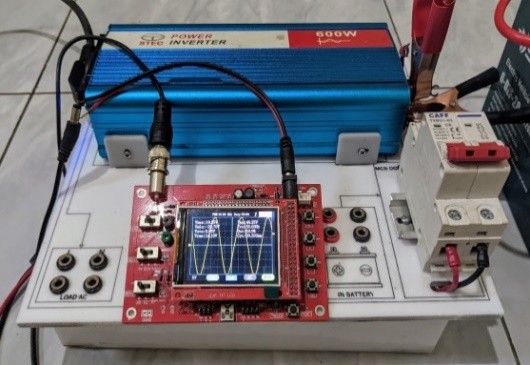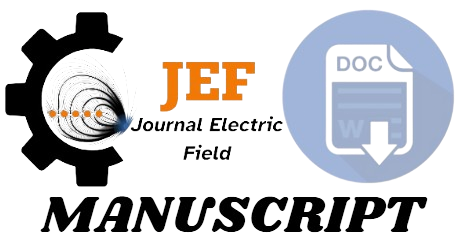Pengaruh Pembebanan RLC Terhadap Stabilitas Daya Semu dan Kinerja Sistem Pembangkit Listrik Tenaga Bayu (PLTB)
DOI:
https://doi.org/10.63440/jef.v2i1.104Keywords:
Wind Power Plants, Renewable Energy, RLC, Power Stability, Apparent Power StabilityAbstract
This study aims to evaluate the impact of RLC loading on the power stability and power quality in Wind Power Plant (PLTB) systems. The RLC is applied to stabilize the power generated by the PLTB system, which tends to fluctuate due to wind speed variability. The testing was conducted by measuring the output power of the PLTB system loaded with various RLC configurations. The results show that RLC loading can enhance the apparent power stability and efficiency of the PLTB system. The resistive load (R) yielded the best performance, improving the power factor to 0.95 and maintaining relatively stable output voltage. Meanwhile, the LC loads exhibited lower efficiency with a reduced power factor, but still played a role in balancing reactive power. The reduction in reactive power for inductive and capacitive loads indicates that RLC loading can help reduce power waste and improve power quality. This research makes a significant contribution to the development of more efficient and stable PLTB systems and more reliable renewable energy-based power plants, particularly in managing power stability in the face of fluctuations caused by wind variability.
Downloads
References
A. R. Idris, F. Siampa, N. A. Noor3, and S. Thaha, “Rancang Bangun Pembangkit Listrik Tenaga Bayu Sumbu Vertikal,” J. Teknol. Elekterika, vol. 4, no. 1, p. 28, 2020, doi: https://doi.org/10.31963/elekterika.v4i1.2251
M. Hadi and I. Syaukani, “Literature Review: Metode Evaluasi Performa Sistem Pembangkit Listrik Tenaga Surya (PLTS) di Indoensia,” RELE (Rekayasa Elektr. dan Energi) Jurnal Tek. Elektro, vol. 8, no. 1, pp. 280–289, 2025, [Online]. Available: https://jurnal.umsu.ac.id/index.php/RELE/article/view/22193/12539
A. Laksana, S. Sutisna, and F. M. S. Nursuwars, “Kontrol Sistem Charging Pembangkit Listrik Tenaga Bayu Pt. Lentera Bumi Nusantara Berbasis Internet of Things (IoT),” J. Energy Electr. Eng., vol. 3, no. 1, 2021, doi: https://doi.org/10.37058/jeee.v3i1.3390
T. Sutikno, H. S. Purnama, R. A. Aprilianto, A. Jusoh, N. S. Widodo, and B. Santosa, “Modernisation of DC-DC converter topologies for solar energy harvesting applications: A review,” Indones. J. Electr. Eng. Comput. Sci., vol. 28, no. 3, pp. 1845–1872, 2022, doi: https://doi.org/10.11591/ijeecs.v28.i3.pp1845-1872
H. Sun, C. Qiu, L. Lu, X. Gao, J. Chen, and H. Yang, “Wind turbine power modelling and optimization using artificial neural network with wind field experimental data,” Appl. Energy, vol. 280, pp. 1–18, 2020, doi: https://doi.org/10.1016/j.apenergy.2020.115880
I. Eguinoa et al., “Wind farm flow control oriented to electricity markets and grid integration: Initial perspective analysis,” Adv. Control Appl. Eng. Ind. Syst., vol. 3, no. 3, 2021, doi: https://doi.org/10.1002/adc2.80
M. A. Baihaqi et al., “Analisis Dampak Pembebanan RLC terhadap Kualitas Daya dan Efisiensi Energi pada Pembangkit Listrik Tenaga Surya 100 WP On-Grid,” JASIEK (Jurnal Apl. Sains, Informasi, Elektron. dan Komputer), vol. 6, no. 1, pp. 1–10, 2024, doi: https://doi.org/10.26905/jasiek.v6i1.11267
M. Nuryogi and Subiyanto, “Performa Pembangkit Listrik Tenaga Bayu Terhubung Grid Pada Pembebanan Dinamis,” Renew. Energy J., vol. 8, no. 2, pp. 64-70, 2019, doi: https://doi.org/10.15294/eej.v8i2.28117
E. R. Mauboy, “Pengaruh Pertambahan Beban Terhadap Kestabilan Tegangan Dalam Pemodelan Pembangkit Listrik Tenaga Angin,” J. Media Elektro, vol. X, no. 1, pp. 53–56, 2021, doi: https://doi.org/10.35508/jme.v0i0.3892
Rudy Gianto, “Pemodelan Pembangkit Listrik Tenaga Bayu Kecepatan Variabel untuk Analisis Aliran Daya,” J. Nas. Tek. Elektro dan Teknol. Inf., vol. 11, no. 3, pp. 222–228, 2022, doi: https://doi.org/10.22146/jnteti.v11i3.1749
W. Hardi et al., “Desain dan Optimasi Turbin Angin Sumbu Vertikal Kombinasi Type Darius dan Type Savonius untuk Meningkatkan Efesiensi Pembangkit Listrik Sumber Energi Terbarukan,” Rekayasa Energi Manufaktur) J., vol. 9, no. 1, pp. 2528–3723, 2024, [Online]. Available: http://doi.org/10.21070/rem.v9i1.1693
M. M. Herbalubun, W. Hardi, and R. Hartono, “Unjuk Kerja Turbin Angin Sumbu Vertikal dengan Optimasi Panjang Turbin,” Dinamika, vol. 6, pp. 58–62, 2021, doi: https://doi.org/10.33387/dinamik.v6i2.4107
P. G. Chamdareno, G. H. Suyonoputra, and Budiyanto, “Perancangan Turbin Angin Sumbu Vertikal dengan Memanfaatkan Angin pada Ruas Jalan Tol,” Resist. (Elektronika Kendali Telekomun. Tenaga List. Komputer), vol. 7, no. 1, pp. 155–164, 2024, doi: https://doi.org/10.24853/resistor.7.2.155-164
N. Khusnawati, R. Wibowo, and M. Kabib, “Analisa Turbin Angin Sumbu Horizontal Tiga Sudu,” J. Crankshaft, vol. 5, no. 2, pp. 35–42, 2022, doi: https://doi.org/10.24176/crankshaft.v5i2.7683
M. Mursid, R. H. A. Shiddieqy, B. Raafi’u, A. T. Zain, Taufiqurrohman. A, Patrialova, Novendra. S, “Rancang Bangun Pembangkit Listrik Tenaga Angin Dan Surya Menerapkan Konsep Hybrid Technology Berbasis Internet of Things,” 2021, [Online]. Available: https://sipora.polije.ac.id/15075/
K. C. Sindang, B. Mukhlis, Y. Arifin, and ..., “Pengaruh Pembebanan Terhadap Sistem Eksitasi Generator Sinkron Sf 33.065 Pada Pembangkit Listrik Tenaga Air (PLTA) Poso 1 Energy,” Pros. Semin. Nas. Tek. Elektro dan Inform., pp. 393–397, 2023, [Online]. Available: https://jurnal.poliupg.ac.id/index.php/sntei/article/view/3583
C. Baxevanou, D. Fidaros, C. Papaioannou, and N. Katsoulas, “Design and Optimization of a Hybrid Solar–Wind Power Generation System for Greenhouses,” Horticulturae, vol. 9, no. 2. MDPI AG, p. 181, 2023. doi: https://doi.org/10.3390/horticulturae9020181
F. Iov, A. D. Hansen, C. Jauch, P. Sørensen, and F. Blaabjerg, “Advanced Tools for Modeling, Design and Optimization of Wind Turbine Systems Copyright (C) 2005 NuriMedia Co., Ltd.,” Power, no. C, vol. 5, no. 2, pp. 83–98, 2005, [Online]. Available https://koreascience.kr/article/JAKO200516610479871.page
J. Liew, R. Riva, M. Friis-Møller, and T. Göçmen, “Wind Farm Control Optimisation Under Load Constraints Via Surrogate Modelling,” J. Phys. Conf. Ser., vol. 2767, no. 9, 2024, doi: https://doi.org/10.1088/1742-6596/2767/9/092039
R. Arindya, “Penerapan Doubly-Fed Induction Generator (Dfig) Untuk Pembangkit Listrik Tenaga Angin,” J. Edukasi Elektro, vol. 1, no. 1, pp. 57–61, 2017, doi: https://doi.org/10.21831/jee.v1i1.10439
A. R. Utami and I. G. Mulyana, “Optimization of Hybrid Power Plant System to Increase Reliability by Maximizing Renewable Energy (Case Study: Semau Island),” J. Edukasi Elektro, vol. 8, no. 2, pp. 112–124, 2024, doi: https://doi.org/10.21831/jee.v8i2.70933
M. Jaszczur, M. Borowski, J. Halibart, K. Zwolińska-Glądys, and P. Marczak, “Optimization of the Small Wind Turbine Design-Performance Analysis,” J. Computation, vol. 12, no. 11, pp. 1-18, 2024, doi: https://doi.org/10.3390/computation12110215

Downloads
Published
Issue
Section
License
Copyright (c) 2025 Mas Ahmad Baihaqi, Hartawan Abdillah, Winda Ayu Mundari, Tamam Asrori, Alief Muhammad, Alief Muhammad, Dani Hari Tunggal Prasetiyo (Author)

This work is licensed under a Creative Commons Attribution-ShareAlike 4.0 International License.









